- Tumblr Posts







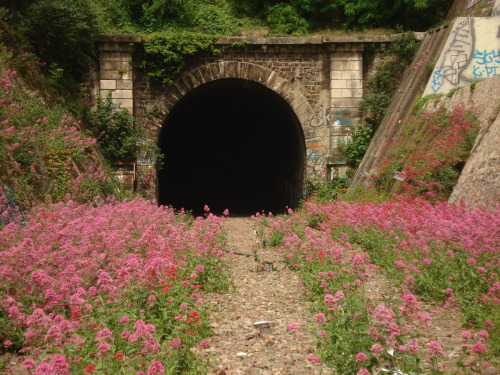


Железнодорожная линия La petite ceinture, Париж, Франция
Двухпутная железнодорожная линия La petite ceinture была построена между 1852 и 1869 годами и изначально была предназначена для грузовых поездов, чтобы те могли обходить Париж. Отсюда, кстати, и название: Petite Ceinture, или «малый пояс».
В течение почти 100 лет линия служила одним из главных средств передвижения в Париже.
Однако с появлением метро и развитием автомобильного транспорта популярность транспортного канала стала падать. Вскоре на Le petite centure ездили только товарные поезда. А в 1934 году большая часть линии была закрыта, а оставшийся её маленький кусок функционировал до 1985 года. С тех пор La petite ceinture остаётся заброшенной за исключением небольшого участка - из части дороги сделали прогулочный маршрут, а через другую небольшую его часть пролегают пути электрички.
За прошедшие годы «малый пояс» остался почти нетронутым, только зарос мхом и плющом. Сейчас для посещений официально открыты всего лишь несколько километров путей – от вокзала Отёй (Gare d’Auteuil) до вокзала Муэтт (Gare de la Muette), они охраняются мэрией и давно уже превратились в оазис, где произрастают более 200 видов растений и проживают 70 видов живых существ, включая белок, ежей, лис, енотов и прочей, не совсем что бы городской, живности.
Railway line La petite ceinture, Paris, France .
The double track La petite ceinture was built between 1852 and 1869 and originated to be tied to freight trains that could bypass Paris. position, by the way, and the name: Petite Ceinture, or "small belt". For almost 100 years, the line served the main means of transportation in Paris.
However, with the advent of the metro and the development of road transport, the popularity of the transport channel began to decline. Soon only freight trains were running on Le petite centure. And in 1934, most of the line was closed, and the remaining small piece of it functioned until 1985. Since then, La petite ceinture has remained abandoned, with the exception of a small section - a walking route was made from part of the road, and train tracks run through another small part of it.
Over the past years, the "small belt" has remained almost untouched, only overgrown with moss and ivy. Now only a few kilometers of tracks are officially open to the public - from the Gare d'Auteuil station to the Muette station (Gare de la Muette), they are protected by the mayor's office and have long turned into an oasis where more than 200 plant species grow and 70 species live living creatures, including squirrels, hedgehogs, foxes, raccoons and other, not quite urban, living creatures.
redeveloper.ru/redeveloperskie-proekty/potential/zheleznodorozhnaya-liniya-la-petite-ceinture-parizh-frantsiya/
Руины санатория «Гульрипш» Николая Николаевича Смецкого. Абхазия.











Красный корпус


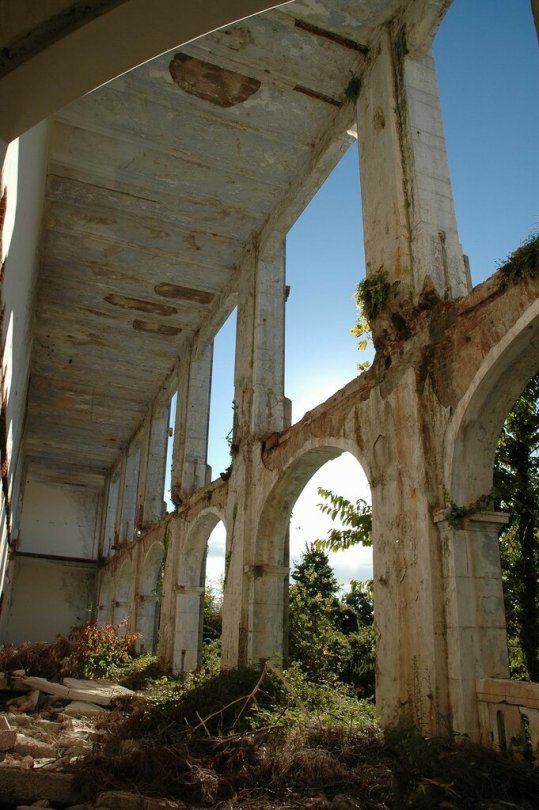
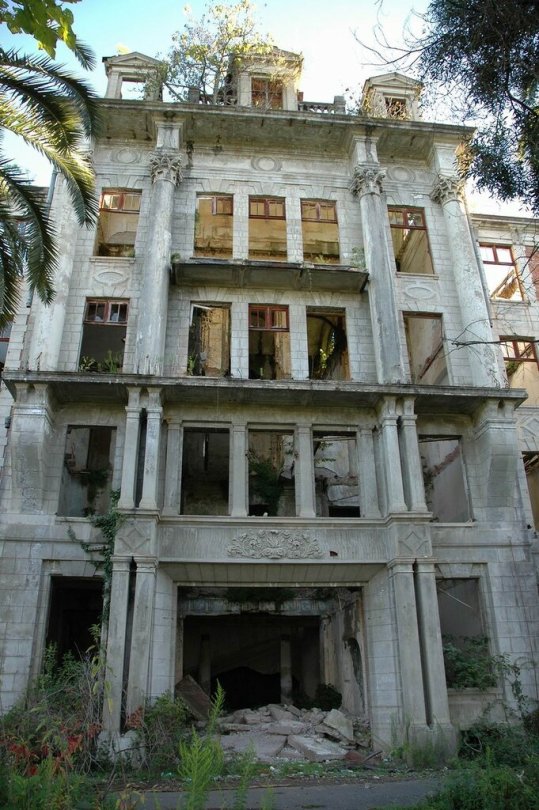




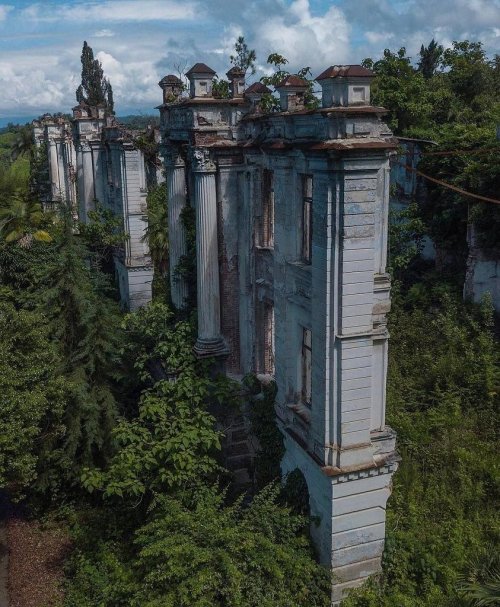
Белый корпус Руины двух корпусов туберкулезного санатория «Гульрипш» дореволюционной постройки находятся недалеко от автодороги в 10 км к юго-востоку от Сухума.
В 1913 г. Смецким был построен четырёхэтажный Красный корпус из 112 комнат на 250 мест. На то время это здание было самым большим в Абхазии. Рядом был устроен огромный сад, где росли кокосы, агавы, акации. Про это здание существует забавная легенда. Якобы жена Смецкого сама была больна туберкулезом, и от одного врача он услышал совет: сделайте так, чтобы каждую ночь она спала на новом месте, где воздух чист от бацилл. Для этого и был построен дом-дворец из 365 комнат, который помог женщине выздороветь.В 1914 году Смецкий передал Красный корпус Красному Кресту для лечения инвалидов войны. Белый корпус в 1916 году был передан Министерству просвещения для лечения учителей и учащихся. В 1922 году дворцы национализировали и устроили в них санаторий имени Ленина.
Ruins of the sanatorium "Gulripsh" of Nikolai Nikolaevich Smetsky.
The ruins of two pre-revolutionary buildings of the Gulripsh tuberculosis sanatorium are located near the highway 10 km southeast of Sukhum. In 1913, Smetsky built a four-story Red building of 112 rooms with 250 seats. At that time this building was the largest in Abkhazia. Nearby there was a huge garden where coconuts, agaves, and acacias grew. There is a funny legend about this building. Allegedly, Smetsky’s wife herself was sick with tuberculosis, and from one doctor he heard advice: make sure that every night she sleeps in a new place where the air is clear of bacilli. For this purpose, a house-palace of 365 rooms was built, which helped the woman recover.
In 1914, Smetsky donated the Red Corps to the Red Cross for the treatment of war invalids. The White Building was transferred to the Ministry of Education in 1916 for the treatment of teachers and students. In 1922, the palaces were nationalized and a sanatorium named after Lenin was built in them.
Вот как эти строения выглядели раньше, архивные фото.
This is what these ruins looked like before, archival photos.





Источник : :https://ru-abandoned.livejournal.com/1690647.html
//idei.club/raznoe/10915-dvorec-smeckogo-v-abhazii.html.
//yarkolp.livejournal.com/4799.html
//dzen.ru/a/YGcj4mCNXCBzoNEt?utm_referer=www.google.com
glebzverev.ru/abkhazia/sukhum-sanatoriy-smetskogo.htm






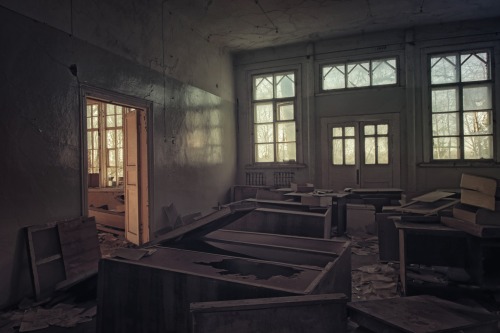












Заброшенная больница судорабочих в Рыбинске.
Ансамбль деревянных зданий расположен на левом берегу Волги на Бурлацкой улице, и скромно стоит в тени лип. С дороги хорошо виден главный корпус с надписью «Больница». Улица не случайно называется Бурлацкая, а на набережной Рыбинска стоит памятник бурлаку. Когда-то Рыбинск был негласной столицей бурлаков, профессии тяжелой и теперь давно забытой. Каждый год тысячи бурлаков стекались в город в дореволюционные годы.
Больница появилась в 1880 году. Первый вклад сделал купец А.Ф. Фролов, отдав под больницу свою землю, за ним и другие горожане пожертвовали деньги на строительство лечебницы. Вскоре были построены первые здания. Весь ансамбль больницы построен в неорусском стиле. Исполнение вызывает уважение мастерством обращения с деревом. Обшивка доской выполнена поперек, вдоль и ёлочкой, красив деревянный, резной на просвет фриз, изящная обналичка, детали выноса крыши, сохранилась мелкая расстекловка окон, филенчатые двери.Вообще, удивительно, что все эти деревянные постройки сохранились до сих пор и на территории больницы не было не одного пожара.
Врачи здесь принимали больных только во время навигации, лечение было бесплатным.Бурлаки и другой рабочий люд могли получить медицинскую помощь, постель, еду и приличное одеяние. Профиль больница сохранила и в советские времена. Сюда обращались речники и жители левого берега Волги. В 90-е жизнь в больнице начала угасать. Закрылся хирургический корпус, уехали врачи. Двери пустующих зданий заколотили, охранять ветшающие памятники культурного наследия оставили старенького сторожа.В 1993 году все здания больницы судорабочих были признаны выявленными памятниками культурного наследия.
Следить за сохранностью имущества сейчас некому, всё активно разрушается и приходит в упадок.Здания производят удручающее впечатление. Стекла в окнах разбиты, крыши сломаны, двери выбиты. В помещениях разбросаны документы. Памятник культуры, построенный рыбинцами, пережил падение империи и 70 лет советской власти. Теперь старой больнице самой нужна забота и лечение, иначе уникальный памятник исчезнет навсегда.
An abandoned hospital for ship workers in Rybinsk.
The ensemble of wooden buildings is located on the left bank of the Volga on Burlatskaya Street, and stands modestly in the shade of lime trees. The main building with the inscription "Hospital" is clearly visible from the road. It is no coincidence that the street is called Burlatskaya, and there is a monument to a boatman on the Rybinsk embankment. Once Rybinsk was the unspoken capital of boatmen, a difficult profession and now long forgotten. Every year thousands of boatmen flocked to the city in the pre-revolutionary years.
The hospital appeared in 1880. The first contribution was made by the merchant A.F. Frolov, who gave his land for the hospital, followed by other townspeople who donated money for the construction of the hospital. Soon the first buildings were built. The entire ensemble of the hospital is built in the neo-Russian style. The execution is respected by the skill of handling wood. The board covering is made across, along and with a herringbone pattern, a beautiful wooden frieze carved into the lumen, elegant cashing, details of the roof removal, small glazing of windows, paneled doors have been preserved.In general, it is surprising that all these wooden buildings have survived to this day and there has not been more than one fire on the territory of the hospital.
Doctors here took patients only during navigation, treatment was free.Boatmen and other working people could receive medical care, a bed, food and decent clothing. The hospital maintained its profile even in Soviet times. Rivermen and residents of the left bank of the Volga applied here. In the 90s, life in the hospital began to fade. The surgical building was closed, the doctors left. The doors of empty buildings were boarded up, and an old watchman was left to guard the dilapidated monuments of cultural heritage.In 1993, all the buildings of the Shipbuilders Hospital were recognized as identified cultural heritage monuments.
There is no one to monitor the safety of property now, everything is actively being destroyed and falling into disrepair.The buildings make a depressing impression. The glass in the windows is broken, the roofs are broken, the doors are knocked out. Documents are scattered in the rooms. The cultural monument built by the Rybintsy survived the fall of the empire and 70 years of Soviet rule. Now the old hospital itself needs care and treatment, otherwise the unique monument will disappear forever.
Источник:://rblogger.ru/2015/12/05/bolnitsa-v-ryibinske/,/vk.com/ wall-24572207_3398,//dzen.ru/a/ YL4FQxs_XCImk2Gs ,/dzen.ru /a/ X8ovW3iO2nXHM3rn.
